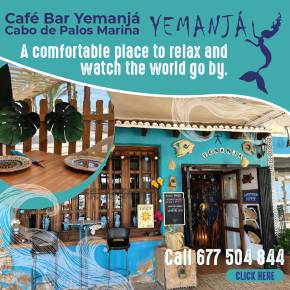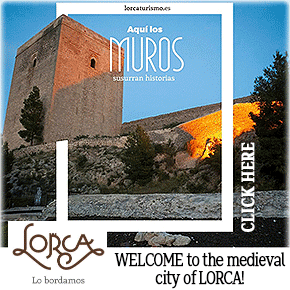September 20 Free tour of the main religious institutions in Caravaca de la Cruz
The city of Caravaca has been attracting Catholic pilgrims since the 14th century
 Caravaca de la Cruz has attracted Catholic pilgrims and other religious tourists ever since the 14th century and this is still reflected in six monasteries, convents and foundations which remain standing to this day.
Caravaca de la Cruz has attracted Catholic pilgrims and other religious tourists ever since the 14th century and this is still reflected in six monasteries, convents and foundations which remain standing to this day.
They helped to enrich the spiritual and cultural life of the city and their presence nowadays helps us to remember the grandeur and splendour of Caravaca in the past.
 This free guided tour on June 21 visits these six foundations and includes explanations (in Spanish) of their historical significance and special characteristics. The route begins at the Castillo-Basílica Santuario de la Vera Cruz with a brief historical introduction and a visit to the chapel where the True Cross itself is kept, continuing to the religious institutions of Santa María de Gracia de Franciscanos, the Monasterio de Santa Clara, the Convento de San José de Carmelitas Descalzas, the Colegio de la Compañía de Jesús, the Convento de Nuestra Señora del Carmen de Padres Carmelitas Descalzos and, to finish, Los Jerónimos.
This free guided tour on June 21 visits these six foundations and includes explanations (in Spanish) of their historical significance and special characteristics. The route begins at the Castillo-Basílica Santuario de la Vera Cruz with a brief historical introduction and a visit to the chapel where the True Cross itself is kept, continuing to the religious institutions of Santa María de Gracia de Franciscanos, the Monasterio de Santa Clara, the Convento de San José de Carmelitas Descalzas, the Colegio de la Compañía de Jesús, the Convento de Nuestra Señora del Carmen de Padres Carmelitas Descalzos and, to finish, Los Jerónimos.
Most of these visits will be outside the buildings but where limited access is permitted entry is included.
The tour begins at 11.00 outside the Basílica de la Vera Cruz and although it is free of charge previous bookings are required online here.
Further information about Caravaca is available from the tourist office (Plaza de España, 7, telephone 968 702424, email turismo@caravacadelacruz.es).
Or for more local information, including the Holy Jubilee Year as well as local news and what’s on, go to the home page of Caravaca Today.
Oficina de Turismo de Caravaca de la Cruz
 More information about the places of interest which can be visited in the municipality of Caravaca de la Cruz, along with what's on and local news can be found in the Caravaca Today.
More information about the places of interest which can be visited in the municipality of Caravaca de la Cruz, along with what's on and local news can be found in the Caravaca Today.
Caravaca de la Cruz, in the north-west of the Region of Murcia, is one of only 5 Holy Cities in the Roman Catholic world, a centre of pilgrimage, along with Rome, Jerusalem, Santiago de Compostela and Santo Toribio de Liebana, and is home to the Cross of Caravaca, the Vera Cruz.
The status of Holy City was bestowed by Pope John Paul II in 1998, granting the City a Permanent Jubilee year every 7 years for perpetuity, the first one held in 2003 and the next in 2024.

The strategic and natural advantages of Caravaca de la Cruz have attracted the attention of settlers for more than 800,000 years, the Cueva Negra yielding remains of Homo Heidelbergensis, forbears of the Neanderthals and the municipality also houses important archaeological remains from the Argaric, Iberian and Roman cultures. many of these can be seen in the Municipal Archaeological Museum.
 As a border town caught between the Catholic forces of Castille and the last remaining Moorish stronghold in Spain, Granada, Caravaca had a turbulent medieval history, but it was during this period that the legend of the Cross of Caravaca was born, bringing the religious orders which shaped the structure of Caravaca today, with its impressive hilltop castle and eclectic collection of churches and monasteries, religious tourism today being a backbone of the town´s economy.
As a border town caught between the Catholic forces of Castille and the last remaining Moorish stronghold in Spain, Granada, Caravaca had a turbulent medieval history, but it was during this period that the legend of the Cross of Caravaca was born, bringing the religious orders which shaped the structure of Caravaca today, with its impressive hilltop castle and eclectic collection of churches and monasteries, religious tourism today being a backbone of the town´s economy.
Caravaca de la Cruz is a municipality with important natural resources, including extensive forests, part of which have protected status due to their wealth of flora and fauna, and due to the abundant water supplies is also a major area for canned fruit production, apricots in particular being an important crop.
 Caravaca is renown for its important May Fiestas, held in honour of the Vera Cruz, which also incorporate the Moors and Christians celebrations and the Running of the Wine Horses.
Caravaca is renown for its important May Fiestas, held in honour of the Vera Cruz, which also incorporate the Moors and Christians celebrations and the Running of the Wine Horses.
Caravaca de la Cruz is also the home of Europe´s largest collection of ethnic instruments at Barranda, the Museo de Música Étnica Barranda and is the location of the Barranda festival de Cuadrillas, which celebrates the Region's ethnic music traditions.
The municipality is home to around 26,000 inhabitants and shares boundaries with Moratalla, Cehegín, Lorca, Puebla de Don Fadrique in the province of Granada and Vélez-Blanco in the province of Almería.
Opening times:
Weekdays: 10.00 to 14.00 and 16.30 to 19.30
Saturdays: 10.30 to 14.00 and 16.30 to 19.30
Sundays and public holidays: 10.30 to 14.00
Click for map, Caravaca de la Cruz Tourist Office






























